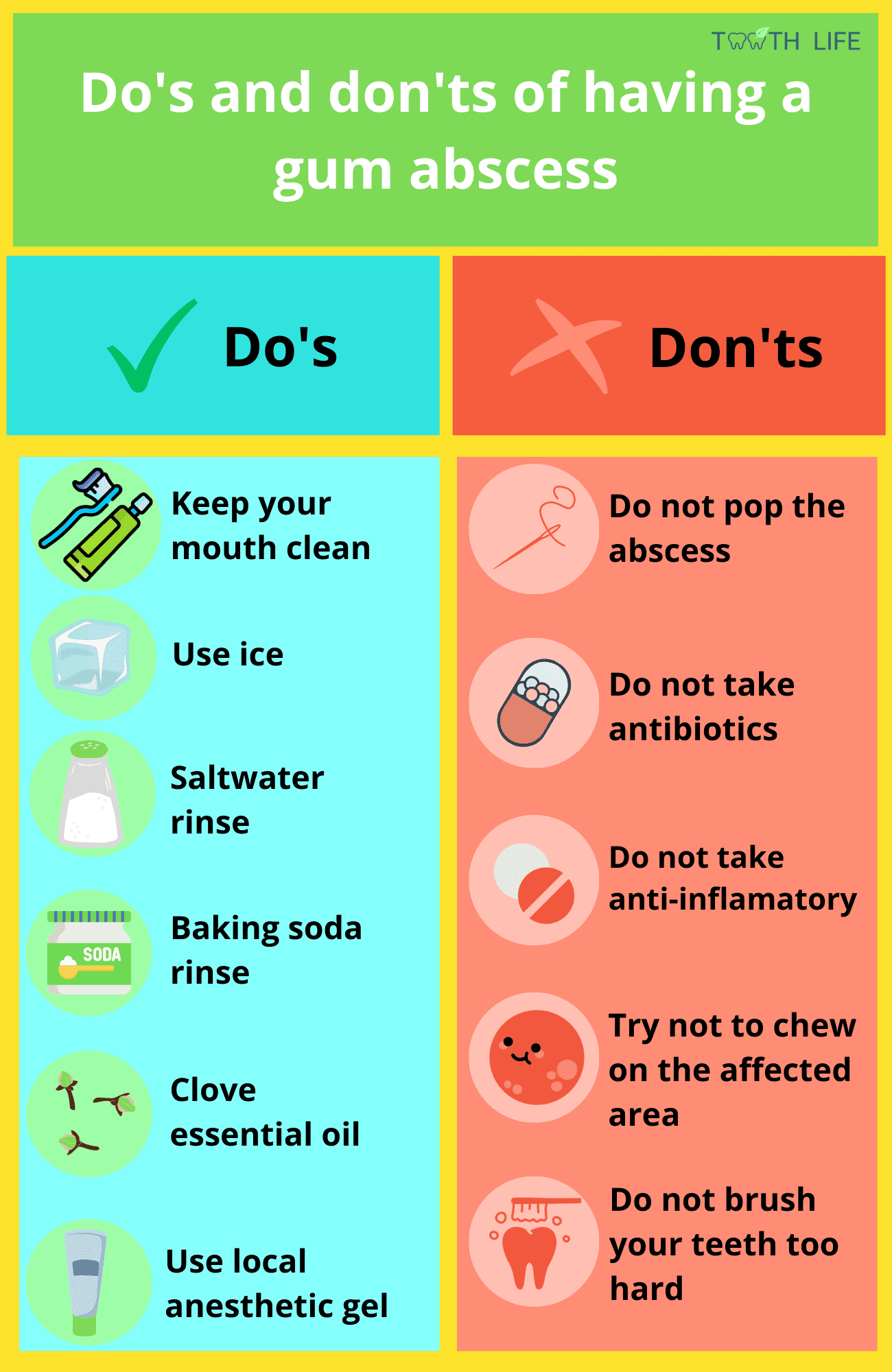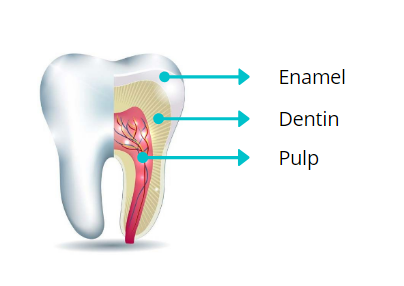Gum Abscess Drainage at Home: Dos and Don'ts for Pain Relief
 A gum abscess is the final stage of a dental infection. When bacteria take over your mouth, your immune system gets overwhelmed and cannot defend itself. As a result, the bacteria destroy your tissue and a pocket of pus forms around the infected area.
A gum abscess is the final stage of a dental infection. When bacteria take over your mouth, your immune system gets overwhelmed and cannot defend itself. As a result, the bacteria destroy your tissue and a pocket of pus forms around the infected area.
There is a big misconception about this. You may think that a gum abscess is a disease in itself and that draining it would end the story. However, the boiling or swelling you see is only a symptom of an underlying infection. The treatment involves dealing with the root cause rather than its symptoms.
In this article, we'll look in more detail at the gum abscess, the do's and don'ts of home care, and how to treat it properly.
What is a gum abscess?
A gum abscess is a painful condition of bacterial origin that results from a pocket of pus building up on the gum. If the bacteria gain access to the deeper tissues, such as through a crack or decay, they overgrow and trigger an acute inflammation.This can lead to various symptoms, including swelling, redness, pain, and even fever.
The two most common dental abscesses are periapical and periodontal.
The first occurs when bacteria get inside the tooth's nerves (the pulp), usually through a cavity.
The second also occurs on the gum but is unrelated to the tooth's nerve. It appears following gum disease when the tissues surrounding the tooth (the bone and the gum) become infected by virulent bacteria.
Can a gum abscess heal on its own?
The short answer is no. Once again, the gum abscess itself is only a symptom of another infection. As long as the real cause is not treated, the abscess will never be able to heal itself.Only when the decay is limited to the outer layer of the tooth can you perhaps do something to reverse the situation. However, when the decay reaches the pulp and the bacteria manage to get inside, it is the point of no return.

The pulp, which is the soft tissue in the center of the tooth that carries its nerves and blood vessels, runs through the roots in thin tubes called root canals.
Each infected root canal can contain millions of bacteria of different species that will eventually defeat the immune system. The products of the reactions will accumulate and move down the gums to form an abscess or boil.
As long as the source of the infection, which in this case is the root canal, is not treated (with root canal therapy), the gum abscess can never heal by itself.
What not to do at home if you have a gum abscess?
If you think you have a gum abscess, the first thing to do is make an appointment with your dentist as soon as possible. In the meantime, there are some things you don't want to do to avoid making the infection worse. Here are the most common bad practices for abscessed teeth:- Trying to pierce the abscess yourself: One of the most pointless things to do is try to pierce the abscess or pop it on your own. If you don't know what you are doing, not only this may hurt, but you can actually make the infection worse. Plus, this would only hide the swelling temporarily, and it'll come right back after a few days. So it's best to leave it to the professionals who can treat the real problem.
- Taking anti-inflammatory medications: Anti-inflammatory drugs like ibuprofen and aspirin can provide temporary relief from pain and swelling. However, it's important to know that these medications can actually lower the immune response, allowing bacteria to grow and thrive silently without symptoms.
As the delicate balance between bacteria and the immune response is disrupted, the infection risks spreading even further.
A study found that patients taking anti-inflammatory drugs had more severe acute dental infections and a higher risk of complications.
While waiting to see your dentist, consider taking painkillers other than anti-inflammatory drugs like acetaminophen (such as Tylenol and Panadol). - Taking antibiotics: While antibiotics can help treat a bacterial infection, they are not always necessary or effective for treating a gum abscess. In some cases, antibiotics may even contribute to the development of antibiotic-resistant bacteria, making the abscess more difficult to treat.
- Chewing on the affected side: Chewing on the side where the abscess is located can exacerbate the pain and swelling. It can also put pressure on the abscess, causing it to rupture and potentially spread the infection to other parts of your mouth.
- Flossing or brushing too hard: It's important to be gentle when cleaning your teeth and to use a soft-bristled toothbrush and a non-abrasive toothpaste to avoid further irritating the affected area.
What can you do for your gum abscess?:
While you wait for your appointment, you can try some home remedies to relieve yourself. Remember that these solutions can only temporarily mask the symptoms and do not cure the infection at its root.- Maintain good oral hygiene: It's important to continue to brush and floss your teeth, being gentler in the affected area. This will keep the bacterial load in your mouth low, thus preventing the infection from spreading.
- Apply ice to the painful area: Applying ice to the affected area can help to reduce pain and swelling. Simply wrap an ice pack or a bag of frozen vegetables in a towel and hold it against the affected area for 10 to 20 minutes at a time.
- Baking soda rinse: Mix a tablespoon of baking soda with warm water. Baking soda rinse will help you offset the acidity and reduce inflammation.
- Saltwater rinse: Dissolve a teaspoon of salt in warm water and use it as a rinse to help reduce inflammation and pain.
- Hydrogen peroxide rinse: This is a powerful antiseptic, naturally secreted with saliva by our body. Mix equal parts of hydrogen peroxide and water and use it as a rinse to help kill harmful bacteria in your mouth. Be sure not to swallow the mixture.
- Clove essential oil: Clove oil has natural soothing, anti-inflammatory, and antibacterial properties that can help to reduce pain and swelling. Apply a small amount of clove oil to a cotton swab and hold it against the affected area for a few minutes.
- Local anesthetic gel: You can use over-the-counter numbing gels directly to the affected area to help reduce pain and discomfort. Be sure to follow the instructions carefully and avoid using the gel too frequently or in excessive amounts.
My gum abscess went away by itself. Did it heal?
An abscessed gum may occasionally regress or go away on its own, but this does not mean that it has healed. This could be explained by the fact that the immune system has found a certain balance with the bacteria. But at any time, this balance can break down, leading to an exacerbation of the reactions and the appearance of a new abscess.Another scenario is where the pain subsides on its own. Again, this does not in any way suggest healing.
Abscesses can sometimes drain on their own, releasing the pressure that has built up in the pocket. While this can bring relief from the pain and swelling, it doesn't address the underlying infection that caused the abscess in the first place.
If the infection is not properly treated, it can continue to spread and potentially lead to more serious health complications.
Potential complications of an untreated gum abscess:
If left untreated, a gum abscess can lead to serious complications, including:- Spread of infection: An untreated gum abscess can cause the infection to spread to other parts of the body, including the jaw, neck, or brain. This can lead to serious health complications, such as meningitis, brain abscess, or sepsis.
- Bacterial endocarditis: Bacteria from gum abscesses can reach the heart through the bloodstream. They can then affect parts of it, leading to potentially fatal heart dysfunction.
- Sepsis: Bacteria reaching the bloodstream can cause a general inflammatory response. People with low immunity, such as diabetics or HIV sufferers, are most at risk of developing this condition. This can lead to vital organ failure and death.
- Tooth loss: As the abscess grows, the bone shrinks and gets weaker. The tooth can then become loose and eventually come out.
- Difficulty eating and speaking: A gum abscess can cause pain and swelling that makes it difficult to eat or speak comfortably. This can affect your quality of life.
- Ludwig's Angina: The infection can spread down the jaws and around the airways. This condition is fatal as it can obstruct breathing and cause death by asphyxiation.
How does your dentist treat your gum abscess properly?
The specific treatment of a gum abscess depends on the severity and extent of the infection to the surrounding tissue. The first thing to do is to drain the pus to relieve the pressure and give you relief. Next, your dentist will remove the root cause to prevent the abscess from recurring. Here are the basic steps in how your dentist will manage your abscess.1. Drainage of the abscess:
The abscess can be drained in 3 different ways:
Root canal:
The first way to drain a gum abscess is to perform a root canal. Your dentist will make an opening in the tooth and pass fine instruments to the root tip so that the pus flows up, out, and through the tooth. Afterward, your dentist will disinfect and clean your tooth and fill it temporarily.
Gum incision:
If the abscess has not drained properly with root canal treatment, your dentist will make a small incision in the gum to allow the pus to drain out. This will give you immediate relief. Then he will clean and debride the affected area to remove any remaining debris and bacteria.
Tooth extraction:
If the tooth is too damaged or the infection is too severe, the dentist may need to extract the tooth to prevent the infection from spreading.
2. Antibiotics:
Antibiotics are not always necessary. In most cases, drainage is sufficient to heal a gum abscess. However, if the infection is severe, spreading to the surrounding tissue, or if you have a medical condition that weakens your immune system, your dentist may prescribe antibiotics after the drainage to eradicate the infection and bacteria.
Follow-up care:
Your dentist will schedule follow-up appointments to monitor your progress and recovery and ensure that the infection has been completely eliminated.
